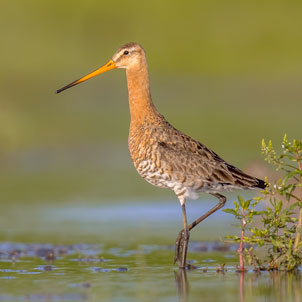Wetland wildlife in April
The spring arrivals are in full flow and new life is all around; April is here. Take a look at our guide to the wonderful wetland life that you can find this month.
The clocks have gone forward and spring has truly sprung. This is the peak time for spring migration. Whilst we watch for incoming birds, many have started breeding already and it’s a great time to stumble across flowering wetland plants, too.
Migration is in full swing
Last month we saw the first of our species that migrate here to breed and with recent mild weather and light southerly winds, the birdlife is piling in. You might have already been lucky enough to see a little ringed plover, sand martin or garganey on your local wetland but many more species will continue to arrive. The majority are coming all the way from sub-Saharan Africa, having spent the winter on wetlands, in forests and around the coasts of the continent. This means they now need to cross the largest subtropical desert in the world, a journey of over 4,000 miles. As the month goes on, the list of species arriving grows: osprey, hobby, common tern, swallow, yellow wagtail, sedge warbler, reed warbler and cuckoo are all winging their way towards us this month. Their ultimate aim is to find a partner in good nesting habitat and raise the next generation during the next few months whilst food is plentiful.

Another, rather special breeding migrant is the black-tailed godwit. A rare breeder in the UK, around 60 pairs breed on wetlands in the east of England. Since 2017, WWT has been ‘head-starting’ hand-reared chicks to boost the population.

Look out for the early breeders
It’s not just the incoming migrant species that are making themselves known. Quiet during the winter, male bitterns can now be heard booming from deep inside their reedbed homes, staking out territory. They’re hard to spot but the best time to hear them is early morning. On the contrary, familiar birds such as moorhen and coot can now be easily spotted on their nests. It’s also a key time for waders; oystercatchers have been known to choose very obvious locations, but you’ll need to look a little harder to get a view of nesting avocet, lapwing or redshank.

For amphibians too, new life continues to grow. The tadpoles that were free-swimming in March will be getting larger and now the toadpoles and newt larvae that were recently laid as eggs will be emerging too.
The first wetland flowers
Along with the flourishing fauna, April is a month for seeking out wetland plant life. It’s the best month for marsh marigolds, or ‘kingcups’, as they show off their gaudy flowers, a signpost for pollinators. In wet woodland, birch trees are producing their catkins, joining the alder and willow already in flower. The pink petals of the cuckoo flower will soon appear across wet grassland; these plants get their name as historically the flowers appear at the same time as the bird is first heard. The orange-tip butterfly lays eggs on the plant stems, but eventually there will only ever be one caterpillar per plant due to the caterpillar’s tendency for cannibalism.

If April is the month to look out for incoming migrants, then May is the time to witness them setting about nesting and producing offspring. Wetland plants will continue to come out in flower and we’ll be able to witness the emergence of the first dragons…
What species might you see at each of our centres?
You can find more detailed information on each centre's 'Wildlife' and 'Latest sightings' pages but here is a handy overview:
- Keep an eye out for any of the above-mentioned migrating birds at any WWT wetland centre. They might be just stopping off for a rest and refuel ‘on passage’, or they will be settling in to breed.
- Washington have a large common tern breeding colony but they can also be seen breeding at Castle Espie, Slimbridge, Martin Mere, London, Llanelli, Steart Marshes and Welney. There’s also a chance at Arundel this year as new habitat and rafts have recently been provided.
- Ospreys have bred successfully at Caerlaverock every summer since 2006; in 2020 and 2021, the regular pair nested and had 3 chicks each year; all were female and all fledged successfully. At our other sites, you’re more likely to see them passing through on migration.
- Head to Welney this month to spot black-tailed godwit as they arrive back to their wet grassland habitat to breed. Lots of other waders use WWT wetlands for breeding territory; lapwing are at all sites apart from Castle Espie and Steart Marshes; oystercatcher at all sites apart from Castle Espie and Llanelli.
- Avocet can be seen breeding at Martin Mere, Slimbridge, Washington, Welney and Steart Marshes. Common redshank breed at Caerlaverock, London, Martin Mere, Slimbridge, Washington and Welney. And of course the ubiquitous coot and moorhen can be seen at all WWT sites.
- Breeding toads and newts have potential to be seen at all of our wetland sites, as do marsh marigolds, cuckoo flowers and birch trees.
Support from players of People's Postcode Lottery helps us care for our reserves and protect amazing wetland wildlife.



